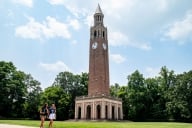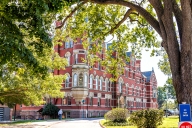You have /5 articles left.
Sign up for a free account or log in.
Jewish student leaders say they now have a robust community at Stanford, but university officials used to impose limits on Jewish student admissions.
Stanford Hillel
Stanford University leaders are seeking to make amends for past actions by former administrators who systematically and secretly discriminated against Jewish students seeking admission to the university.
A task force of Stanford scholars, students and staff members released a report earlier this month that details how the former university administrators took active steps to curb the number of Jewish students admitted to the university in the early 1950s and repeatedly denied doing so in response to suspicions raised by parents, alumni and trustees and multiple probes by the Anti-Defamation League in the 1950s and ’60s. The report includes a series of recommendations for improving present-day Jewish life on campus, based on focus groups and interviews with Jewish students.
“On behalf of Stanford University I wish to apologize to the Jewish community, and to our entire university community, both for the actions documented in this report to suppress the admission of Jewish students in the 1950s and for the university’s denials of those actions in the period that followed,” Stanford president Marc Tessier-Lavigne said in a statement. “These actions were wrong. They were damaging. And they were unacknowledged for too long.
“Today, we must work to do better, not only to atone for the wrongs of the past, but to ensure the supportive and bias-free experience for members of our Jewish community that we seek for all members of our Stanford community,” he added.
The report comes at a time when colleges and universities across the country are excavating their pasts and working to publicly acknowledge and correct for their roles in historic wrongs. Brown University issued a groundbreaking report in 2006 uncovering its ties to the slave trade, jump-starting similar efforts at other institutions, including Georgetown University, which has made efforts to make amends for the sale of 272 enslaved people in 1838. Harvard, for example, announced this year that it would dedicate $100 million to redress its entanglements with slavery. Colleges have renamed campus buildings and programs in efforts to atone for past connections to problematic campus leaders and donors. Land acknowledgments, which list Native tribes who once lived on the lands where campuses sit, have become commonplace on course syllabi.
Ari Y. Kelman, chair of the Stanford task force and Jim Joseph Professor of Education and Jewish Studies, sees Stanford’s deep dive into its history on admissions as a part of this broader movement.
“Everybody is taking a good, hard look at their own history,” he said. “Higher education is beginning to reassess its place and its own relationship to its own history, and this was a chance to do that here.”
He believes this is the first institutional response to past restrictions on admissions of Jewish students, and he characterized the president’s apology as a “landmark moment” that could inspire other college and university leaders to also dig deep into the past and reckon with these troubling histories.
Examining the Past
The task force was commissioned by campus leaders in January to explore claims made in an online newsletter, written by Charles Petersen, a postdoctoral fellow in history at Cornell University who did archival research at Stanford as a graduate student for his dissertation.
Petersen wrote about uncovering an unsettling 1953 memo to the Stanford University president, Wallace Sterling, from his assistant. The assistant told Sterling that the then admissions director, Rixford Snyder, was concerned too many “Jewish boys” were applying to the university and that accepting students from two predominantly Jewish high schools in Los Angeles could lead to a “flood of Jewish applications.”
It’s unclear whether the president ever saw the memo or responded, but the task force noted that several other administrators put their initials on the memo, indicating they had read it. Snyder, who directed admissions for two decades, ultimately excluded these two heavily Jewish schools from his recruitment efforts, and enrollment among students who graduated from them notably dropped. Between 1949 and 1952, Stanford enrolled 67 students from Beverly Hills High School and 20 students from Fairfax High School. From 1952 to 1955, Stanford enrolled 13 students from Beverly Hills High School and only one from Fairfax.
Ivy League institutions in the Northeast in the 1920s, such as Harvard, Columbia and Yale Universities, were known for restricting the number of Jewish students and developed application processes with that goal in mind, said Emily J. Levine, an associate professor of education and a historian who served on the Stanford task force. California, however, had a comparatively small Jewish population, so she was surprised to see Stanford officials ruminating so intensively on unremarkable enrollment levels from these high schools.
“There’s a kind of cultural amnesia around the history of antisemitism in our country and these institutions,” Levine said. “And I think unearthing this surprising story has given our students and our community the language with which to think about Jews as the object of bigotry, as the preoccupation of the establishment, as this source of concern from which our entire modern admissions system and its selection process originates.”
Karla Goldman, Sol Drachler Professor of Social Work and a professor of Judaic studies at the University of Michigan, said since elite institutions now have robust communities of Jewish students, it’s easy to forget how this community was perceived by administrators in the 1920s.
The attitude among many campus officials at the time was “here are campuses designed for gentlemen, sons who are going to be the leaders of our banks and our institutions, suddenly flooded with the children of Eastern European immigrants who did not have the same social graces, who are coming, many of them, from urban settings,” said Goldman, who studied how University of Michigan administrators approached Jewish student admissions. “There are accents. They don’t know how to dress.”
Some administrators believed high numbers of Jewish students would deter their “bread and butter” students—white Protestants—from attending, she said. They also falsely assumed Jewish “children of immigrants, tailors and butchers” were less likely to succeed financially and would make for a poorer alumni donor base.
She described the misdeeds uncovered at Stanford as relatively minor compared to those of elite institutions in the Northeast.
“This was happening everywhere, so it’s interesting that Stanford took this piece as seriously as they have,” she said. “It’s to their credit. But does it mean there should be a wave of these things everywhere? Truly, almost every school in the Northeast should be apologizing.”
Task force members agreed that they found less evidence of anti-Jewish bias among officials at Stanford than scholars have found at other institutions. They believe that’s partly because of the timing; overt Jewish quotas at colleges and universities fell out of fashion after World War II, but more subtle policies to limit Jewish students continued discreetly at Stanford and elsewhere.
Kelman, chair of the task force, said antisemitism has changed over time, and limits on Jewish student admissions are a thing of the past, but a lack of public understanding and discourse about antisemitism allows it to persist.
“It’s the silence and the kind of inability, or lack of a conceptual framework or lack of a theory, or lack of understanding for what antisemitism is or was, that allowed it to fester in the early 1950s and that I think is allowing it to propagate nowadays,” he said.
Looking Toward the Future
About 600 Jewish undergraduates and between 1,000 and 1,200 Jewish graduate students and postdocs are currently enrolled at Stanford, according to estimates from Stanford Hillel, an organization focused on Jewish student life on campus. Data from the university show Stanford enrolled 7,645 undergraduates and 9,292 graduate students in total in fall 2021.
The presidents of the Jewish Student Association, Ashlee Kupor and Sophia Danielpour, said in a statement that they were “disappointed” by the report’s findings but “also appreciative that Stanford allowed a thorough discovery process and issued a real apology.
“We hope this report helps Stanford and other institutions look at DE&I more inclusively, which would be a really positive step,” the statement said. “Today, we have a very vibrant Jewish community on campus. While there are sometimes anti-semitic incidents on campus and being an observant student can be very difficult, it is wonderful that we have this community to take care of each other during these difficult times.”
The report offers a number of recommendations on how to better support the current Jewish student population. It encourages the university to undertake a comprehensive study of Jewish life on campus; ensure the first day of classes doesn’t fall on Jewish holidays, as it has in years past; and consider religious accommodations such as expanding kosher dining options. The report also asks that information about Jewish identity and antisemitism be included in relevant diversity trainings and educational programming and that the university clarify its relationship with the campus Hillel, among other suggestions.
Branches of Hillel exist at campuses across the country, and the extent of their relationships to their corresponding universities varies, said Rabbi Jessica Kirschner, executive director of Stanford Hillel. Sometimes Hillel staff members are considered university personnel and universities fundraise for Hillel activities, while other Hillels have varying levels of independence. Stanford Hillel is completely independent from the university, which she’s found “frustrating” in some ways.
She would like to see Stanford offer more support to Hillel with fundraising and for Hillel to have closer partnerships with campus staff members engaged in diversity, equity and inclusion work to ensure Jewish students are included.
“A DEI framework that’s oriented around U.S. census-box identities has enormous blind spots for religious minorities and the ways in which religious minorities enjoy some advantages in our society and also significant disadvantages,” she said. “Who are we thinking about when we think about communities that might be impacted by their minority status?”
She also highlighted that Jewish identity can be both religious and ethnic and is often misunderstood.
“We are a multiracial, multinational community,” she said. “We are made up of religiously observant people and religiously less observant people. That doesn’t mean their Jewish identity isn’t core to who they are, and it doesn’t mean that they can’t experience significant discrimination based on that identity, whether or not they go to synagogue on Saturday morning.”
She’s grateful Stanford has given a “full-throated” apology for its past and is making moves to improve Jewish life on campus today.
Levine described the research process as a form of “teshuva,” the Hebrew word for “repentance.” She said it was especially fitting that the report was released on the heels of the Jewish High Holiday season, traditionally a time to reflect and atone for sins.
Looking at the past and apologizing for it “are prior conditions for changing behavior in the present,” she said.


.png)




_edit.jpg?itok=d3X97aqv)

